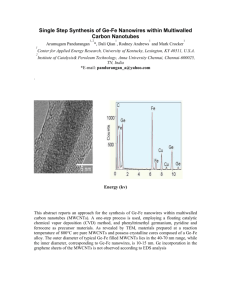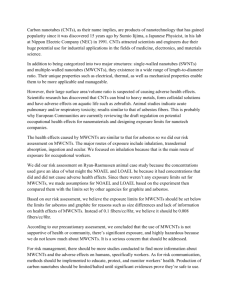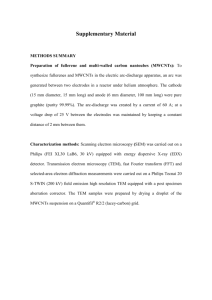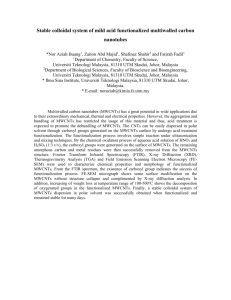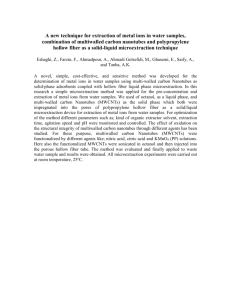Physicomechanical Characteristic of Slag Geopolymer Mortar Enhanced with Multiwall Carbon Nano-tube
advertisement
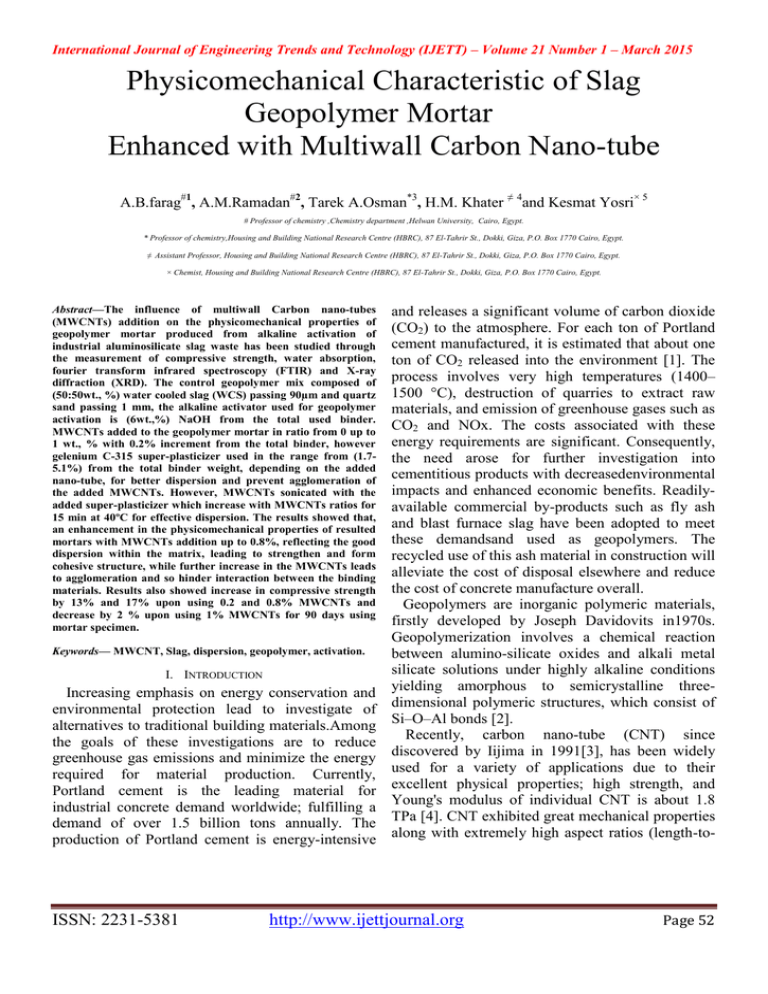
International Journal of Engineering Trends and Technology (IJETT) – Volume 21 Number 1 – March 2015 Physicomechanical Characteristic of Slag Geopolymer Mortar Enhanced with Multiwall Carbon Nano-tube A.B.farag#1, A.M.Ramadan#2, Tarek A.Osman*3, H.M. Khater ≠ 4and Kesmat Yosri× 5 # Professor of chemistry ,Chemistry department ,Helwan University, Cairo, Egypt. * Professor of chemistry,Housing and Building National Research Centre (HBRC), 87 El-Tahrir St., Dokki, Giza, P.O. Box 1770 Cairo, Egypt. ≠ Assistant Professor, Housing and Building National Research Centre (HBRC), 87 El-Tahrir St., Dokki, Giza, P.O. Box 1770 Cairo, Egypt. × Chemist, Housing and Building National Research Centre (HBRC), 87 El-Tahrir St., Dokki, Giza, P.O. Box 1770 Cairo, Egypt. Abstract—The influence of multiwall Carbon nano-tubes (MWCNTs) addition on the physicomechanical properties of geopolymer mortar produced from alkaline activation of industrial aluminosilicate slag waste has been studied through the measurement of compressive strength, water absorption, fourier transform infrared spectroscopy (FTIR) and X-ray diffraction (XRD). The control geopolymer mix composed of (50:50wt., %) water cooled slag (WCS) passing 90µm and quartz sand passing 1 mm, the alkaline activator used for geopolymer activation is (6wt.,%) NaOH from the total used binder. MWCNTs added to the geopolymer mortar in ratio from 0 up to 1 wt., % with 0.2% increment from the total binder, however gelenium C-315 super-plasticizer used in the range from (1.75.1%) from the total binder weight, depending on the added nano-tube, for better dispersion and prevent agglomeration of the added MWCNTs. However, MWCNTs sonicated with the added super-plasticizer which increase with MWCNTs ratios for 15 min at 40ºC for effective dispersion. The results showed that, an enhancement in the physicomechanical properties of resulted mortars with MWCNTs addition up to 0.8%, reflecting the good dispersion within the matrix, leading to strengthen and form cohesive structure, while further increase in the MWCNTs leads to agglomeration and so hinder interaction between the binding materials. Results also showed increase in compressive strength by 13% and 17% upon using 0.2 and 0.8% MWCNTs and decrease by 2 % upon using 1% MWCNTs for 90 days using mortar specimen. Keywords— MWCNT, Slag, dispersion, geopolymer, activation. I. INTRODUCTION Increasing emphasis on energy conservation and environmental protection lead to investigate of alternatives to traditional building materials.Among the goals of these investigations are to reduce greenhouse gas emissions and minimize the energy required for material production. Currently, Portland cement is the leading material for industrial concrete demand worldwide; fulfilling a demand of over 1.5 billion tons annually. The production of Portland cement is energy-intensive ISSN: 2231-5381 and releases a significant volume of carbon dioxide (CO2) to the atmosphere. For each ton of Portland cement manufactured, it is estimated that about one ton of CO2 released into the environment [1]. The process involves very high temperatures (1400– 1500 °C), destruction of quarries to extract raw materials, and emission of greenhouse gases such as CO2 and NOx. The costs associated with these energy requirements are significant. Consequently, the need arose for further investigation into cementitious products with decreasedenvironmental impacts and enhanced economic benefits. Readilyavailable commercial by-products such as fly ash and blast furnace slag have been adopted to meet these demandsand used as geopolymers. The recycled use of this ash material in construction will alleviate the cost of disposal elsewhere and reduce the cost of concrete manufacture overall. Geopolymers are inorganic polymeric materials, firstly developed by Joseph Davidovits in1970s. Geopolymerization involves a chemical reaction between alumino-silicate oxides and alkali metal silicate solutions under highly alkaline conditions yielding amorphous to semicrystalline threedimensional polymeric structures, which consist of Si–O–Al bonds [2]. Recently, carbon nano-tube (CNT) since discovered by Iijima in 1991[3], has been widely used for a variety of applications due to their excellent physical properties; high strength, and Young's modulus of individual CNT is about 1.8 TPa [4]. CNT exhibited great mechanical properties along with extremely high aspect ratios (length-to- http://www.ijettjournal.org Page 52 International Journal of Engineering Trends and Technology (IJETT) – Volume 21 Number 1 – March 2015 diameter ratio) ranging from 30 to more than many thousands. They are expected to produce significantly stronger and tougher cement composites than traditional reinforcing materials (e.g. glass fibers or carbon fibers). ). In fact, because of their size (ranging from 1 nm to 100 nm) and aspect ratios up to 1000, CNT can be distributed in a much finer scale, giving as a result more efficient crack bridging at preliminary stage of crack propagation within cement composites. However, properties and dimensions of CNT strongly depend on the deposition parameters and the nature of the synthesis method, i.e., arcdischarge [5], laser ablation [6], or chemical vapor deposition (CVD) [7]. In view of a commercial application, the arc-discharge technique is the only one that can offer a path towards low-cost and large scale production [8],[9]. In fact, CNT, obtained with a complete graphitization process achieved by heat-treatment at high temperature [10], either in vacuum or inert environment, show outstanding mechanical properties [11]. On the other hand, while lattice defects limit mechanical strength, they are reactive spots that can be used to produce functional groups on the outer walls by chemical treatments with acid solutions. These superficial chemical groups, such as carboxylic (–COOH) groups, can originate strong chemical bonds between CNT and cementitious matrix, thus enhancing high reinforcement efficiency even thought to the detriment of graphitization degree [12],[13]. Furthermore, chemical treatments can help to dissperse the bundles; hence facilitate a uniform dispersion at the single tube level, especially in aqueous media such as that for cement composites. Proper dispersion and adequate load transfer are the main challenges in the search for efficient CNT reinforced cement composites [14]. Chen et al. [15] provided a complete literature review of CNT-cement nanocomposites; their review focused on the effect of CNTs on the properties of OPC including fabrication, hydration, mechanical properties, porosity and transport, conductivity and piezoresistivity. It was found that the dispersion of CNTs in cement remains one of the main challenges in improving the fabrication of CNT–OPC mixtures. Adequate dispersion of CNTs in cement is challenging as van der Waals forces ISSN: 2231-5381 are responsible for their bundling and agglomeration even at very low concentrations, thereby limiting their potential benefits [15],[16]. The enhancement of mechanical and electrical properties depends on how well the CNTs are dispersed within the cement matrix. The literature review highlighted many inconsistent results on the effect of CNTs on the mechanical properties of OPC. However, it is well established that the current. Mechanical properties of CNT–OPC are not satisfactory for structural applications indicating further research is needed to find ways to uniformly disperse CNTs in cement [15]. In terms of durability, previous studies on the effect of CNTs on the pore structure of CNT–OPC composites suggested that CNTs can act as nucleating sites for the cement hydration and as a result, the overall porosity and pore continuity are reduced [15]. The alkaline activation used to process geopolymers has the potential to enhance the interaction of MWCNTs with the geopolymeric matrix by two positive effects, leading to improved mechanical and electrical properties. The first one is the effect of sodium hydroxide (NaOH) on the dispersion of MWCNTs within the geopolymetric matrix. Previous studies have shown that NaOH acts as a surfactant and removes the oxidation debris from the surface of CNTs and consequently allowing them to de-bundle and form well dispersed nanotubes within the matrix [16]. The main goal of our research work is to evaluate the optimum ratio of MWCNTs, which results in an enhancement in the performance of geopolymer mortar mixes, upon studying the mechanical strength, XRD, FTIR, and water absorption of the hardened geopolymer structures. II. EXPERIMENTAL WORK A. The used Material Materials used in this investigation are wellgrinned water cooled slag passing a sieve of 90 μm, sourced from Iron and Steel Company, Helwan governorate, Egypt, Sand sourced from Oases (Wahat)-Road, Egypt and finally Sodium hydroxide (NaOH) used as alkali activators purchased from http://www.ijettjournal.org Page 53 International Journal of Engineering Trends and Technology (IJETT) – Volume 21 Number 1 – March 2015 SHIDO Company (Leningradskaya Oblast, Russia) with 99% purity. The used water cooled slag and sand were analyzed by means of a chemical analysis as represented in Table (1) and identified by means of XRD as represented in Fig.1 which indicate that water cooled slag is mainly amorphous and sand is mainly consist of quartz. B. Synthesis and Characterization of MWCNts Carbon Nano-tubes which used for enhancing of geopolymeric mortar are of multiwall type consisting of many nested cylinders whose successive radii differ by roughly the interlayer spacing of graphite. The morphology and microstructure of the as-synthesized carbon nanomaterials were characterized by transmission microscope (TEM), as shown in Fig.2,which depicts the representative TEM image of assynthesized carbon nanotubes deposited on 50% Co/MgO by Acytelen gas decomposition at 700 ºC reaction temperature and ~ 4h time-on-stream. These images show that the morphologies have tubular structures, i.e. they are multi-walled carbon nanotubes (MWCNTs) and the boundaries between MWCNT tubes are clear. The diameters of the MWCNTs are mostly in the range of 14–24 nm. TABLE 1 OXIDE CONTENT OF RAW MATERIALS Oxide content(%) Sio2 Al2O3 Fe2O3 WCS 36.67 10.31 0.50 Sand 93.80 1.43 0.73 CaO major bands were observed, representing D-and Gbands. The D- bands, observed at 1250–1350 cm−1, is known as either the disorder induced due to the wall disorder or the presence of amorphous carbon deposited on the outer surface of nanotubes. The Gband (observed at 1550–1600 cm−1) can be attributed to the degree of graphitization of MWCNTs. The ratio of ID/IG of the D and G-band can be regarded as an index for the crystalline order of MWCNTs; the high ID/IG value (> 1) indicates that there is high structural disorder in the carbon nanotubes obtained on the catalysts. However the lower ID/IG value (< 1) suggests the enhancement in graphitization of deposited carbon. The high intensity of the G-band (417 cm-1) relative to Dband (270.7 cm-1) (ID/IG ratio ≈ 0.65) suggests that the MWCNTs synthesized under the optimum conditions were highly graphitized [18]. Thermo-gravimetric analysis (TGA) is very important tool for clarifying the yield, stability and quality of the as-grown MWCNTs, as indicated in Fig.1d where the catalyst presented a single oxidation inflection, which indicates that the amorphous carbon is extremely low and high purity MWCNTs are produced, also, TGA Data determine the onset, and offset (end) temperatures represent the temperature at the initial weight loss,( 496 ºC) and the final weight loss, (692 C) respectively. The Na2O MnO SO3 Cl TiO2 K2O P2O5 38.82 0.48 4.04 2.17 - 0.57 - 0.04 1.02 0.22 - 0.45 0.53 0.09 0.34 0.18 SrO 0.18 - BaO MgO Loss Total 3.28 1.70 0.12 99.90 0.12 1.04 99.95 - Large difference between the onset and end It is obvious in Fig. 2 (a, b) the dark object in the temperature (192 ºC) is attained on the catalyst. pictures is related to the Co metal particles of the catalyst. Raman spectroscopy was employed to analyzed the degree of grahitizationof the produced MWCNTs as represented in Fig. 2c; where the two ISSN: 2231-5381 http://www.ijettjournal.org Page 54 International Journal of Engineering Trends and Technology (IJETT) – Volume 21 Number 1 – March 2015 This can be attributed to the formation of large diameters of MWCNTs, which are proved by TEM photos Figure 2(a, b). Based on these results, the formation of ideal graphitized carbon nanomaterials and the highest carbon yield are gained on it. C. Dispersion of MWCNTs The MWCNTs were first mixed with Gelenium C315-polycarboxylate based super-plasticizer and 50% of the added water. This Polycarboxylatebased superplasticizer has been proven to be effective for CNTs dispersion [19]. The solution was sonicated using a Fritish 450 Sonifier Analog Cell Distributor for 15 min [20]. Solutions with concentration of [0.2, 0.4, 0.6, 0.8 and 1-wt., %] of the total weight of the matrix were used to identify the MWCNTs concentrations for the evaluation of the threshold ratio of MWCNTs. III. SYNTHESIS AND CURING The alkaline activator composed of 6 wt., % NaOH, and prepared 24hr prior to casting. The Geopolymer mortar is reinforced with MWCNTs concentrations: [0.0 (control), 0.2, 0.4, 0.6, 0.8 and 1-wt., %] of the binder weight.Accordingly, mixing was performed as follows: Geopolymer was made by hand-mixing of raw materials for each mixture passing a sieve of 90 µm as represented in Table (2) according to the following sequence: ISSN: 2231-5381 1. The previously prepared MWCNTs particles sonicated for 15 min with 50 % of the added water and the specified quantity of the gelenium C315 super-plasticizer for better dispersion of nano-tubes materials under a temperature of 40oC. 2. The geopolymer materials passing a sieve of 90 µm as represented in Table (2) were hand mixing with the alkaline activator solution which dissolved in the remaining water content for 10 minute followed by a further 5 minute using rotary mixer and mixed at medium speed (80 rpm) for another 30 s. 3. The MWCNTs and super plasticizer were added and stirred with mixture at high speed for additional 30 s. 4. The mixture was allowed to rest for 90 s and then mixed for 1 min at high speed. 5. Immediately after molding, the specimens were cured at room temperature for the first 24 hrs. At the end of the moist curing period, the cubes were demoulded and curied in a humidifier chamber at 40°C (100%R.H.) until the time of testing from 3 up to 90days. At the end of curing regime, the specimens were subjected to compressive strength measurements and then the resulted crushed specimens were subjected to stopping of the hydration process by hydration of crushed samples at 105°C for 24 hrs [21]. http://www.ijettjournal.org Page 55 International Journal of Engineering Trends and Technology (IJETT) – Volume 21 Number 1 – March 2015 IV. METHODS OF INVESTIGATION Chemical analysis was carried out using the Axios PW4400 WD-XRF sequential spectrometer (Panalytical, Netherland), CuKα source with a post sample Kα filter. X-ray diffraction (XRD) patterns were collected from 0° to 50° 2θ (step size 0.02° 2θ and speed 0.4°·min−1). Silica quartz was used as an internal standard. Data were identified according to the XRD software (pdf-2: database on CD-Release 2005). Bonding characteristics of geopolymer specimens were analyzed using the Jasco- 6100 Fourier transformed infrared spectrometer (FTIR; Tokyo, Japan).The wave number was ranging from 400 to 4,000 cm−1 [22]. Stopping of hydration was performed on crushed specimens by drying of the crushed samples at 105°C for 24 hrs [21]. Compressive strength measurements were carried out using five tones German Brüf Pressing Machine with a loading rate of 100kg/min. ISSN: 2231-5381 Water absorption can be defined as the increase in the weight of cubes due to the absorbed water within the pore structure, but not including in water adhering to the outside surface of the particles. It is expressed as a percentage to the dry weight and determined according to ASTM C20-2010 [23]. TABLE 2 COMPOSITION OF THE GEOPOLYMER MIXES (MASS, %) Mix No. WCS Sand NaOH% MWCNTs Gelenium C315% W/B C0 50 50 C1 50 50 6 - 1.7 0.28 6 0.2 1.7 0.28 C2 50 50 6 0.4 2 0.283 C3 C4 50 50 6 0.6 2.5 0.288 50 50 6 0.8 3.3 0.296 C5 50 50 6 1 5.1 0.314 http://www.ijettjournal.org Page 56 International Journal of Engineering Trends and Technology (IJETT) – Volume 21 Number 1 – March 2015 V. RESULT AND DISCUSSION XRD patterns of control mix as well as geopolymer mixes with [0.2, 0.8, 1 wt, %] MWCNTs cured in 100% relative humidity and 40°C at 90 days are shown in Figure (3). The patterns illustrate an increase in the broadness of the band in the region of 6° to 10° 2θ for aluminosilicate gel and at 17° to 35° 2θ related to the glassy phase of the geopolymer constituents up to 0.8(wt., %), this can be explained by the fact; MWCNTs act as nucleation centers for the formation and accumulation of geopolymer [15] [24]. Increasing the addition of MWCNTs of 1(wt,%) results in a pessimism effect by forming agglomerates which are concentrated in a small area and so hinder the formation of geopolymer phase. FTIR spectra of 90days cured control geopolymer specimens having [0.2, 0.8,1 wt, %] MWCNTs is shown in Fig.4. Band descriptions are as follows: stretching vibration of O-H bond in the region 3,429 to 2,300 cm−1, bending vibration of HOH in the region of 1,595 to 1,628 cm−1, stretching vibration of CO2 located at about 1,430 cm−1, asymmetric stretching vibration of T-O-Si at about ISSN: 2231-5381 980 to 1,100 cm−1, where T=Si or Al, CO2 symmetric stretching vibration at about 870 cm−1, symmetric vibration of α-quartz at about 797 cm1 ,symmetric stretching vibration of AL-O-Si between 770 to 780 cm−1, symmetric stretching vibration of Si-O-Si and Al-O-Si in the region 675 to 685cm−1, and bending vibration of Si-O-Si and O-Si-O in the region 450 to 460 cm−1. The pattern illustrate the increase in the intensity of the asymmetric T-O-Si band with MWCNTs increase in addition to the increased peak broadness up to 0.8%, while further increase results in lowering in the previous band intensity. The increased intensity with MWCNTS attributed to the increased content of N-A-Si-H &C-A-S-H, where CNT with high nucleation efficiency enhance geopolymer formation and accumulation in addition to the ability to bind CSH on its surface at the carboxylsites of super-plasticizer by interaction of soluble Ca+2-ions of the pore solution, therefore the carboxyl group of super-plasticizer on the surface of MWCNTs results in the increase in growth of CSH-phases [25]. The pattern clarify also, the increased dissolution of α-quartz of α-quartz of http://www.ijettjournal.org Page 57 International Journal of Engineering Trends and Technology (IJETT) – Volume 21 Number 1 – March 2015 unreacted at silicate up to 0.8%, however, the increased of MWCNTs beyond the latter ratio results in agglomeration within the matrix which has pessimism effect on strengthen structure. Compressive strength values of hydrated control and geopolymer mixes containing various MWCNTs contents from 0.2 up to 1 wt., % at different curing times of 3, 7, 14, 28 and 90 days at 100% relative humidity and 40°C are shown in Fig.5. Evidently, the compressive strength of all mixes increases with curing time as a result of progressive hydration, forming CSH as well as geopolymer formation leading to the formation of a fine and homogeneous structure. The results illustrate an increase in strength by 13%, 17% when using 0.2% and 0.8% MWCNTs and decreased by 2%when using 1% MWCNTs after 90 days as compared with the control mix. The increase in strength confirmed by XRD data fig.3, where increased CSH in addition to the increased hump in the region 17-35 (2°θ) reflects the growth in the ISSN: 2231-5381 amorphous geopolymer constituents. The latter data also confirmed by FTIR spectra fig.4, where the asymmetric band of T-O-Si increases in both intensity and broadness with MWCNTs up to 0.8%, However, the increase of MWCNTs beyond the latter ratio results in agglomeration of the added CNT and so hinder the interaction of the reacting geopolymer materials resulting in the formation of porous matrix with many points of defects and lower strength value. Water absorption of geopolymer mixes containing MWCNTs in the ratios from 0.2 up to 1 wt., % at different curing ages are shown in Fig. 6 Obviously, the results in Fig. 6 indicate the decrease of water absorption with the increase of curing time as a result of progressive hydration with the formation of CSH and geopolymer formation, leading to a denser structure. Evidently, it decreases with increasing MWCNTs content up to 0.8% and then increases slightly up to 1%. The decease of water absorption with increasing MWCNTs is due to the fact that http://www.ijettjournal.org Page 58 International Journal of Engineering Trends and Technology (IJETT) – Volume 21 Number 1 – March 2015 resp ectively, while decreased by 2% upon using 1%MWCNTs for 90days as compered with the control mix. 3-Water absorption decreased with addition of MWCNTs up to 0.8%and increased with further addition. VI. CONCLUSION 4-XRD data illustrate the increase of CSH and 1-MWCNTs showed an enhancement in the amorphous geopolymer constituent with MWCNTs mechanical properties of geopolymer mortar up to 0.8%, while decreases with further increase. compared to the control mix. It was found that the 5-FTIR, clarify the increase of asymmetric band (Taddition of MWCNT to geopolymer mortar can O-Si) for the amorphous geopolymer constituents greatly enhance its compressive strength up. with MWCNTs up to 0.8% and decreases with 2-Compressive strength increased by 13% and 17% further increase. upon using 0.2 and 0.8% MWCNTs addition, when a material with high specific surface area is added to a mix specimen, it acts as a micro-filler of the matrix particles, which can reduce the amount of water that filled in the voids of the blending materials. ISSN: 2231-5381 http://www.ijettjournal.org Page 59 International Journal of Engineering Trends and Technology (IJETT) – Volume 21 Number 1 – March 2015 REFERENCES [1]Sumajouw, DMJ.; Hardjito, D.; Wallah, SE.; Rangan, BV.; “Geopolymer Concrete for a Sustainable Future”, Presented: Green Processing Conference, Fremantle, WA., 2004. [2]Davidovits, J."Chemistry of geopolymeric systems, in: Terminology". Geopolymer’99Second International Conference, Saint-Quentin, France. 1999. [3] Lijima ,S. " Helical microtubes of graphitic carbon Nature" 1991; 354(7); 56-58. [4] Ghandi ,R.; Kamal, D. " Evaluation of Young's modulus of single walled Carbon Nanotubes (SWNT) Reinforced Concrete Composite", Journal of engineering and applied sciences, 2008; 3(6): 504-515. [5] Ando, Y. "the preparation of carbon nanotubes "full Sci Technol 1994; 173-180. [6] Maser, WK.; AM, Martinez, MT. "Production of carbon nanotubes: the lightapproach". Carbon2002;40(10):1685-1695. [7] Oncel, C.; Yurum, Y. "Carbon nanotubes synthesis via the catalytic CVDmethod: areview on the effect of reaction parameters, fullerene, Nanotubes, carbon Nanotubes" 2006; 14:17-37. [8] Li, X.; Cao, A.; Jung, YJ.; Vajtai, R.; Ajayan, PM. "Bottom – up growth of carbon nanotubes multilayers: unprecedent growth Nanoletters".2005; 5(10):1997-2000. [9] Musso, S.; Porro, S.; Giorcelli, M.; Chiodoni, A.; Ricciardi, C.; Tagliaferro, A. "Macroscopic growth of carbon nanotubes mats and their mechanical properties" Carbon 2007; 45: 1133-1136. [10] Andrews, R.; Jacques, D.; Qian, D.; Dickey, EC. Carbon 2001;39: 16811687. [11]Musso, S.; Giorcelli, M.; Pavese, M.; Bavese, M.; Bianco, S.; Rovere, M.;Tagliaferro, A. "Improving macroscopic physical and mechanical properties of thick layers of alignedmultiwall carbon nanotubes by annealing treatment". Diam Relat Mater 2008; 17: 542-547. [12] Osswald, S.; Havel, M.; Gogotsi, Y. "Monitoring oxidation of multiwalled carbon nanotubes by Raman spectroscopy". J Raman Spectrosc 2007;38:728-736. [13] Musso, S.; Porro, S.; Vinante, M.; Vanzetti, L.; Ploeger, R.; Giorcelli, M.;et al. "Modifaction of MWNTs obtained by thermal CVD". Diam Relat Mater. 2007; 16: 1183-1187. [14] Musso, S.; Jean- Marc, T.; Giuseppe, F.; Alberto, T. " Influnce of carbon nanotubes structure on the mechanical behavior of cement composites", composite Science and Technology 2009; 69: 1985-1990. [15] Chen, SJ.; Collins, FG.; Macleod, AJN.; Pan, Z.; Duan, WH.; Wang, CM. "Carbon nanotube-cement: a retrospect". The ISE Journal Part A: Civil Struct Eng 2011;4(4):254–265. [16] Gao, D.; Sturm, M.; Mo, YL." Electrical resistance of carbon-nanofiber concrete". Smart Mater Struct 2009;18(9):1–7. [17] Heister, E.; Lamprecht, C.; Neves, V.; Tîlmaciu, C.; Datas, L.; Emmanuel, F. E.; et al. "Higher dispersion efficacy of functionalized carbon nanotubes in chemical and biological environments". ACS Nano 2010;4(5):2615–2626. [18] Reich, S.; Thomsen, C.; Maultzsch, J. "Carbon Nanotubes: Basic Concepts and Physical Properties". Germany Wiley-VCH, 2004. [19] Collins, F.; Lambert, F.; Duan, WH. "The influence of admixtures on the dispersion, workability, and strength of carbon nanotube–OPC paste mixtures". Cem Concr Compos 2012; 34(9):1067–1074. [20] Weitzel, B.; Hansen, MR.; Kowald, TL.; Müller, T.; Spiess, HW.; Trettin, HFR. "Influence of Multiwalled Carbon Nanotubes on the Microstructure of CSH-Phases” , In proceeding of 13th congress on the Chemistry of Cement, 3-8 july 2011, Madrid, Spain. [21] Bakharev, T. “Thermal behaviour of geopolymers prepared using class F fly ash and elevated temperature curing”. Cement Concrete Res 2006; 36: 1134-1147. [22] Panias, D.; I.P. Giannopoulou; T. Perraki.” Effect of synthesis parameters on the mechanical properties of fly ash-based geopolymers”. Colloids Surfaces A: Physicochem. Eng. Aspects 2007; 301: 246-254. [23]ASTM C20, " Standard Test Methods for Apparent Porosity, Water Absorption, Apparent Specific Gravity, and Bulk Density of Burned Refractory Brick and Shapes by Boiling Water", 2010. [24] Jiang, X.; Kowald, T.; Trettin,R. ”Carbon nanotubes as a new reinforcememt material for modern cement-based binders”RILEM proceeding,2nd international symposium on Nanotechnology in construction 2005;209-213. ISSN: 2231-5381 [25] Kowald, Tl.; Mȕ ller, T.; Spiess,Hw.; Trettin, HFR."Influence of Multi walled carbon Nanotubes on the microstructure of CSH phases", In 13rd international conference of chemistry of cement, Madrid 2011. http://www.ijettjournal.org Page 60
